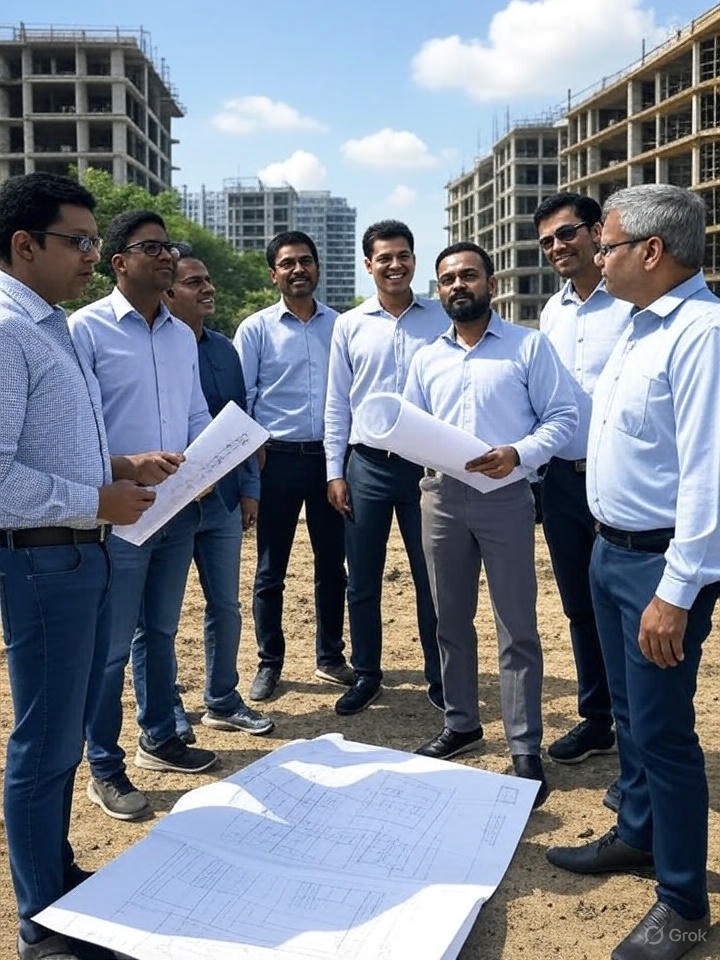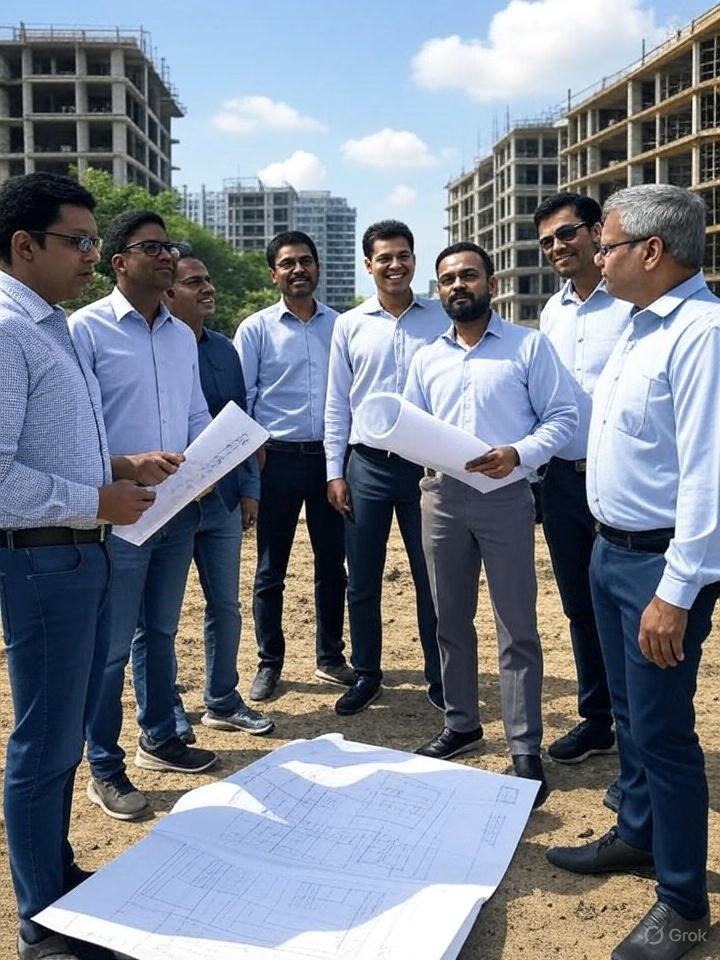
Redevelopment of aging buildings in Mumbai has become a vital solution for cooperative housing societies seeking to modernize their infrastructure, enhance living standards, and unlock the financial potential of their properties. Governed by regulations like Section 79A of the Maharashtra Co-operative Societies Act, 1960, the redevelopment process involves a structured approach, requiring the expertise of project management consultants (PMCs), architects, builders, and active participation from society members. This article outlines the key steps, legal guidelines, and best practices for a seamless redevelopment process in Mumbai.
What is Redevelopment?
Redevelopment refers to the process of demolishing an old or dilapidated building and constructing a new one in its place. In Mumbai, where space is at a premium, redevelopment allows society members to gain larger flats, modern amenities, and often a corpus fund—a financial reserve provided by the builder to the society. For builders, it’s an opportunity to utilize unused development rights, such as additional Floor Space Index (FSI) or Transfer of Development Rights (TDR), to construct extra flats or commercial spaces for profit.
The Role of Section 79A in Redevelopment
Section 79A of the Maharashtra Co-operative Societies Act, 1960, empowers the state government to issue directives to ensure transparency, fairness, and efficiency in the redevelopment process. These guidelines are designed to protect society members from exploitation and ensure compliance with legal and procedural norms. Key directives under Section 79A include:
- Member Consent: At least 51% of society members must provide written consent to initiate redevelopment, and a 75% majority is required to finalize the redevelopment agreement.
- Transparent Selection of Professionals: Societies must appoint a Project Management Consultant (PMC) or architect through a competitive and transparent process.
- Competitive Bidding: The selection of a builder must follow an open tender process to maximize benefits for the society.
- Documentation and Reporting: Quarterly progress reports and detailed financial feasibility studies are mandatory to maintain transparency.
These guidelines aim to address common issues such as lack of transparency, mismanagement, and violations of cooperative laws, ensuring that the process benefits all stakeholders.
Steps in the Redevelopment Process
The redevelopment process in Mumbai, as outlined under Section 79A, is methodical and involves multiple stages to ensure legal compliance and member satisfaction. Below is a step-by-step guide:
1. Initiating the Redevelopment Proposal
The process begins when at least one-fifth of the society members submit a written request to the society’s Managing Committee, proposing redevelopment. This request should include suggestions or schemes for the project. Within eight days, the committee must acknowledge the request and convene a Special General Meeting (SGM) within two months to discuss the proposal.
- Key Action: The SGM agenda must be circulated to all members 14 days in advance, with acknowledgments recorded for transparency.
2. Appointing a Project Management Consultant (PMC) or Architect
Before the SGM, the Managing Committee must invite quotations from at least three architects or PMCs registered with the Council of Architects or empaneled with government or local authorities. During the SGM, which requires a quorum of two-thirds of the total membership, one expert is selected to oversee the redevelopment.
- Role of the PMC/Architect: The appointed professional conducts a survey of the land and building, assesses the available FSI and TDR, and considers government policies (e.g., DCPR 2034, MHADA, or BMC regulations). They also incorporate society members’ suggestions regarding residential and commercial areas, parking, gardens, and other amenities to prepare a feasibility report within two months.
3. Preparing and Approving the Feasibility Report
The feasibility report outlines the project’s scope, including cost estimates, potential additional area, and compliance with local regulations. The society’s secretary displays the report for member inspection eight days before a joint SGM, where members can submit suggestions. During the SGM, the report is reviewed, revised if necessary, and approved by a majority vote.
- Transparency Measures: All notices, minutes, and reports must be uploaded to the society’s website and shared with members via email, registered post, or in person.
4. Selecting a Builder Through Tendering
The approved feasibility report forms the basis for drafting a tender document, which outlines the project’s technical and financial requirements. The PMC or architect invites bids from reputed builders through a competitive tender process. Society members can propose names of experienced developers, and the tender is published on the society’s notice board and website.
- Selection Process: A Managing Committee meeting, attended by bidders and members, evaluates the tenders. The selected builder must be approved by a 75% majority of members present at an SGM. If the chosen builder or their representative is absent, their consent is assumed.
5. Finalizing the Development Agreement
Within one month of selecting the builder, the society, under the guidance of the PMC or architect, enters into a development agreement. This contract includes terms like the corpus fund, additional carpet area, rent compensation for temporary accommodations, and project timelines. The agreement must align with the SGM-approved conditions and comply with Section 79A guidelines.
6. Obtaining Approvals and Commencing Construction
The PMC or architect submits the redevelopment plans to municipal authorities (e.g., BMC, MHADA, or SRA) for approvals, including building permissions and environmental clearances. Once approved, construction begins, with the PMC overseeing quality control, adherence to timelines, and compliance with safety standards.
7. Handover and Post-Completion
Upon completion, the builder hands over the new flats to society members, along with the agreed corpus fund and other benefits. The society ensures that warranties, guarantees, and equipment details are transferred for smooth management of the new building.
Role of Project Management Consultants (PMCs)
A Project Management Consultant (PMC) is pivotal in ensuring a smooth redevelopment process. Their responsibilities include:
- Conducting feasibility studies and preparing detailed project reports.
- Coordinating with architects, engineers, and builders to align the project with society expectations.
- Ensuring compliance with Section 79A and other regulations.
- Managing the tender process and evaluating builder proposals.
- Monitoring construction progress and resolving disputes.
By hiring an experienced PMC, societies can avoid common pitfalls like mismanagement, delays, or legal complications.
Challenges in Redevelopment
Despite the structured process, redevelopment in Mumbai faces challenges, including:
- Lack of Transparency: Some societies fail to involve society members adequately, leading to disputes.
- Mismanagement: Haphazard appointment of builders or poor coordination between PMCs and architects can derail projects.
- Legal Non-Compliance: Ignoring Section 79A guidelines can result in penalties or project delays.
- Member Disagreements: Conflicting opinions among society members can stall decision-making.
To mitigate these, societies must prioritize transparency, adhere to legal guidelines, and engage reputable professionals.
Benefits of Redevelopment
A well-executed redevelopment process offers significant benefits:
- For Society Members: Larger flats, modern amenities, improved safety, and a financial corpus.
- For Builders: Profits from additional saleable space and reduced stamp duty costs compared to new land purchases.
- For Mumbai: Revitalized urban infrastructure, addressing the city’s aging building stock.
Conclusion
The redevelopment process in Mumbai, guided by Section 79A, is a structured yet complex journey that requires careful planning, transparency, and collaboration among society members, PMCs, architects, and builders. By adhering to legal guidelines and engaging experienced professionals, housing societies can transform aging buildings into modern, sustainable structures, enhancing the quality of life for residents while unlocking significant financial value. For societies considering redevelopment, thorough research, member consensus, and compliance with regulations are key to a successful outcome.

